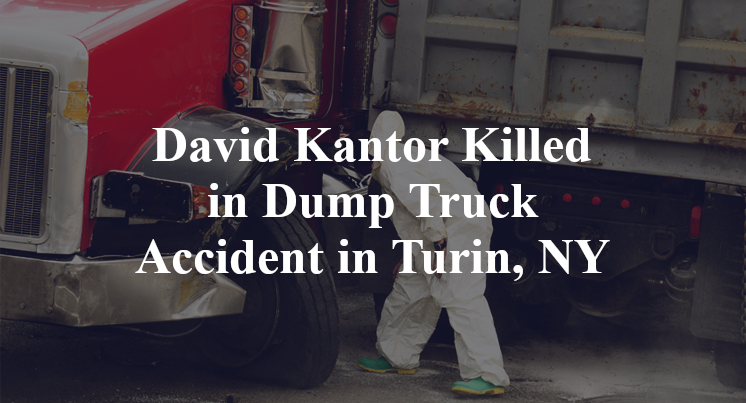David Kantor Killed in Dump Truck Accident in Turin, NY
Turin, NY — May 12, 2025, David Kantor was killed in a dump truck accident at approximately 1:00 p.m. along Gomer Hill Road.
According to authorities, 49-year-old David Kantor was traveling in an eastbound Ford dump truck on Lyman Road in the vicinity of the Gomer Hill Road intersection when the accident took place.

The cause of the accident remains unclear. Officials indicate that, for as yet unknown reasons, the dump truck failed to safely navigate a curve in the roadway. It was consequently involved in a collision with a trailer and excavator that had apparently been parked along Gomer Hill Road.
Kantor reportedly sustained critical injuries over the course of the accident; he was flown to an area medical facility in order to receive immediate treatment. However, he was ultimately unable to overcome the severity of his injuries, having there been declared deceased. Additional details pertaining to this incident are not available at this point in time. The investigation is currently ongoing.
Commentary
In my 30 years handling truck accident cases, I’ve learned that crashes involving single vehicles don’t always mean the fault lies solely with the driver. When a dump truck fails to navigate a curve and strikes equipment parked along a rural road—especially with fatal consequences—the most important legal questions are not just about what the driver did, but about whether the environment, equipment placement, or vehicle condition contributed to the loss of control.
According to reports, the dump truck failed to safely manage a curve before colliding with a trailer and excavator that were parked along Gomer Hill Road. That raises immediate questions: Was the curve too sharp or poorly marked? Were there adequate warning signs, speed advisories, or barriers? Rural roads are often less regulated than highways, but that doesn’t mean they’re free from responsibility. If the road design or maintenance made it difficult for a heavy commercial vehicle to maintain control, that’s a factor that needs to be investigated.
Just as important is the question of whether the dump truck itself was in safe operating condition. Was the steering or suspension worn? Were the brakes working as they should have been? Was the load evenly distributed and properly secured? I’ve seen cases where trucks were sent out with marginal equipment or overloaded beds—conditions that drastically reduce a driver’s ability to handle curves or emergency maneuvers, especially on roads like this one.
Then there’s the matter of what the truck struck. Construction or heavy equipment parked alongside a road must be clearly marked and placed in a way that doesn’t create an added hazard. Were the trailer and excavator parked safely off the roadway? Did they have cones, lights, or reflective markers indicating their position? If not, the people or business responsible for that equipment may share in the legal responsibility for what happened.
And if this dump truck was being operated commercially—as most are—the company that put it on the road also needs to be scrutinized. Did they train the driver adequately for rural routes and curves? Did they conduct regular maintenance checks? Did they assign this route knowing it posed increased risk for the type of vehicle being used? In my experience, these are the kinds of decisions that too often go overlooked—until a fatal crash forces them into view.
Getting to the bottom of a crash like this means asking the right questions and refusing to stop at surface-level explanations. Serious wrecks deserve serious investigation, not assumptions. Understanding whether road conditions, vehicle safety, or equipment placement contributed to the outcome is key to figuring out what might have happened. Getting clear answers to these questions is the least that can be done to help those affected find the clarity and closure they deserve.

“These are essential reads for anyone dealing with the aftermath of a truck wreck”– Attorney Cory Carlson